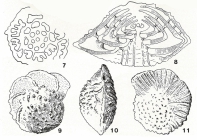Foraminifera taxon details
Praestorrsella Gowda, 1978 †
722397 (urn:lsid:marinespecies.org:taxname:722397)
accepted
Genus
Cibicides roestae Visser, 1951 † accepted as Praestorrsella roestae (Visser, 1951) † (type by original designation)
Lupertosinnia Farinacci, 1996 † · unaccepted (Subjective junior synonym....)
Subjective junior synonym. Opinion of Consorti et al. (2022)
marine, brackish, fresh, terrestrial
fossil only
feminine
Gowda, S. S. (1978). A new genus of foraminifera from the cretaceous rocks of South India. <em>Proceedings of the Indian Academy of Sciences - Section B, Animal Sciences.</em> 87(3): 1-15., available online at https://www.ias.ac.in/article/fulltext/anml/087/03/0001-0015
page(s): p. 1 [details] Available for editors [request]
[request]
page(s): p. 1 [details] Available for editors
Hayward, B.W.; Le Coze, F.; Vachard, D.; Gross, O. (2024). World Foraminifera Database. Praestorrsella Gowda, 1978 †. Accessed at: https://www.marinespecies.org/foraminifera/aphia.php?p=taxdetails&id=722397 on 2024-04-20
Date
action
by
original description
Gowda, S. S. (1978). A new genus of foraminifera from the cretaceous rocks of South India. <em>Proceedings of the Indian Academy of Sciences - Section B, Animal Sciences.</em> 87(3): 1-15., available online at https://www.ias.ac.in/article/fulltext/anml/087/03/0001-0015
page(s): p. 1 [details] Available for editors [request]
[request]
original description (of Lupertosinnia Farinacci, 1996 †) Farinacci, A. (1996). A new nezzazatid foraminifera in the Salento Upper Campanian limestones (southern Italy). <em>Palaeopelagos.</em> 5: 129-137.
page(s): p. 130; note: Originally included in the subfamily Nezzazatinae. [details] Available for editors [request]
[request]
taxonomy source Hottinger, L.; Caus, E. 1993. Praestorrsella roestae (Visser), a foraminiferal index fossil for Late Cretaceous deeper neritic deposits. Zitteliana: 213-221.
page(s): p. 220; note: "P. roestae, as described above, shows general similarities, namely 1. a trochospirally coiled, chambered shell of small size, 2. indications of plastogamic reproduction by its ventral, radial,... [details]
basis of record Loeblich, A. R.; Tappan, H. (1987). Foraminiferal Genera and their Classification. Van Nostrand Reinhold Company, New York. 970pp., available online at https://books.google.pt/books?id=n_BqCQAAQBAJ
note: Included in the subfamily Rotaliinae. [details] Available for editors [request]
[request]
page(s): p. 1 [details] Available for editors
original description (of Lupertosinnia Farinacci, 1996 †) Farinacci, A. (1996). A new nezzazatid foraminifera in the Salento Upper Campanian limestones (southern Italy). <em>Palaeopelagos.</em> 5: 129-137.
page(s): p. 130; note: Originally included in the subfamily Nezzazatinae. [details] Available for editors
taxonomy source Hottinger, L.; Caus, E. 1993. Praestorrsella roestae (Visser), a foraminiferal index fossil for Late Cretaceous deeper neritic deposits. Zitteliana: 213-221.
page(s): p. 220; note: "P. roestae, as described above, shows general similarities, namely 1. a trochospirally coiled, chambered shell of small size, 2. indications of plastogamic reproduction by its ventral, radial,...
"P. roestae, as described above, shows general similarities, namely 1. a trochospirally coiled, chambered shell of small size, 2. indications of plastogamic reproduction by its ventral, radial, ornamentational grooves indépendant of or in addition to sutural positions, 3. dense, heavy ornamentation on the dorsal side, exceptional for shells of such small size, and 4. the group of piles filling the narrow umbilical space, with representative genera of the family Glabratellidae. In addition, there is a striking similarity of the internal morphology of the shell between P. roestae and at least one species of Discorbinoides. Therefore, the genus Praestorrsella Gowda,1978 is transferred here from the rotaliid subfamily Rotaliinae to the family Glabratellidae."
basis of record Loeblich, A. R.; Tappan, H. (1987). Foraminiferal Genera and their Classification. Van Nostrand Reinhold Company, New York. 970pp., available online at https://books.google.pt/books?id=n_BqCQAAQBAJ
note: Included in the subfamily Rotaliinae. [details] Available for editors
From editor or global species database
Diagnosis Test trochospiral, inequally biconvex, spiral side more strongly convex and involute, the extensive calcareous deposits and prominent central and strongly pustulose umbo obscuring all but the latest of the seven to eleven chambers of the final whorl, those sutures visible on the spiral side are thickened, elevated, and curved back at the periphery to grade into the angular peripheral margin, nearly obscured but radial on the umbilical side, no external sutural fissures but septa have rotalid intraseptal passages, central area of umbilical side filled with thick laminar pillars, pierced by vertical canals that open to the surface as large pores; wall calcareous, lamellar, optically radial, finely perforate, center of umbilical side covered with knobs reflecting the ends of the pillars, chambers of the last whorl with numerous ribs that may be radially aligned, the surface knobs, pustules, and ribs obscuring the pores except on the later chambers where they may be visible between the inflational deposits; aperture a simple narrow interiomarginal slit on the umbilical side near the periphery. U. Cretaceous (Santonian to U. Maastrichtian); Netherlands; France; India. (Loeblich & Tappan, 1987, Foraminiferal Genera and Their Classification) [details]
